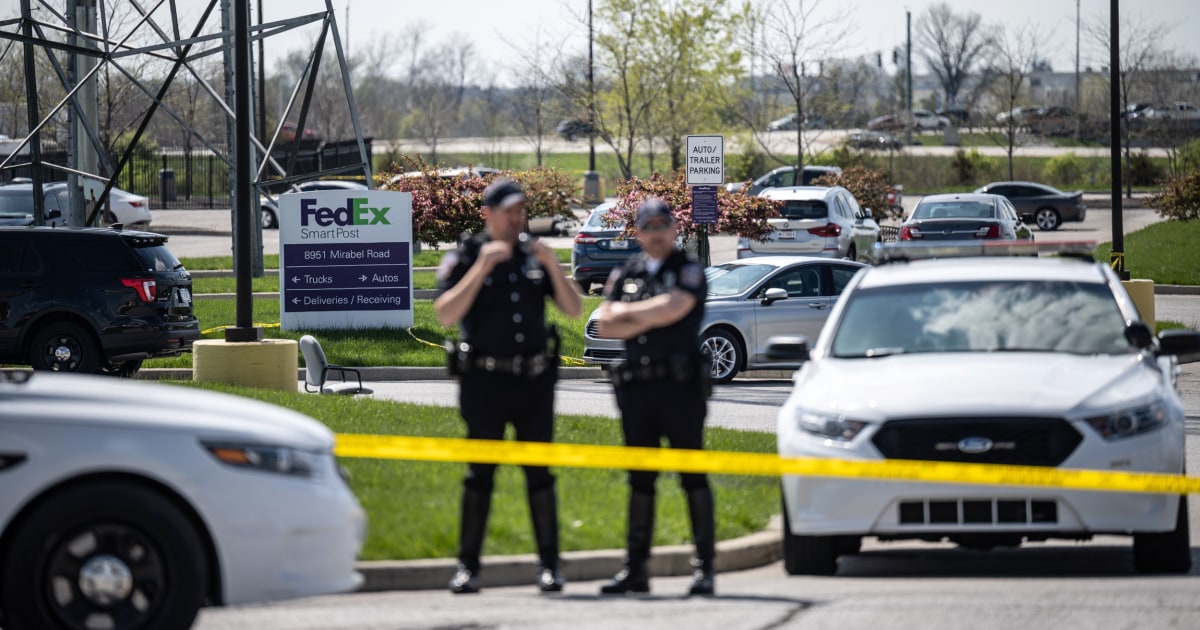
The mass shooting at a FedEx facility in Indianapolis was the deadliest workplace shooting in over a year, and experts warned Friday that such incidents could increase as more people return to work after a year of pandemic-induced isolation.
Eight were killed in the shooting Thursday night, marking the highest number of deaths in a workplace shooting since February 2020, around the start of the pandemic in the U.S., when five people were slain after a co-worker opened fire at the Molson Coors headquarters in Milwaukee, according to statistics compiled by NBC News.
“It’s quite possible there will be an increase in these kinds of killings when people who have been working remotely start to return,” said James Alan Fox, a criminology professor at Northeastern University in Boston and one of the nation’s top experts on mass killings.
Many suffered economic hardship while out of work, he said. Some who felt slighted by supervisors while working from home will be face to face with their bosses for the first time in months.
“Workplace killers see themselves as victims of unfair treatment and want revenge,” Fox said. “They generally think other people are getting the promotions, other people are getting the breaks and somebody has to pay.”
Christopher Herrmann, an assistant professor at the John Jay College of Criminal Justice, agreed.
“It stands to reason that workplace shootings are going to go up,” Herrmann said. “School shootings are going to go up because the kids are back in school. Same with work situations. That’s just going to happen.”
While investigators have identified the Indiana shooter, they have not yet determined a motive.
“Something tells me this is most likely a case of a disgruntled worker who had already been on the job and not somebody just returning to work,” Herrmann said. “FedEx, UPS, Amazon, they were all hiring all through the pandemic.”
But those employees, especially delivery workers, were under increased stress at the peak of the pandemic, Fox said, and some may carry built-up resentments against their employers as they risked their lives to earn a living.
“They weren’t staying home where it was safe and sound,” Fox said. “And you know, you can’t kill the company. But you can hurt the company by committing what’s called murder by proxy.”
The Indiana shooting occurred about a week after police said a Texas man opened fireat a cabinet manufacturing plant in the small city of Bryan, killing one co-worker and wounding five others.
Earlier this year, one person was killed and three others were wounded in a Feb. 9 workplace shooting at a Minnesota medical clinic.
But between the Molson Coors and Minnesota shootings, there were only two workplace shootings with multiple victims, according to the NBC News tally.
Three people were killed on June 26, 2020, at a Bunn-O-Matic warehouse in Springfield, Illinois. The next day, three more people were fatally shot at a Walmart distribution center in Northern California by a recently fired employee who was later killed by police.
The sudden resurgence of mass workplace shootings is not simply the result of more people returning to work, said Lori Ann Post, director of the Buehler Center for Health Policy and Economics at the Northwestern University Feinberg School of Medicine.
“It’s because the pandemic and politics sucked up all the attention last year,” Post said. “The objective of mass shooters is to kill as many people as possible and get as much attention as possible. Now that Covid is starting to decline, and we have a president who is not involved in scandal after scandal, there is more room in the media for something else.”
Homicides actually increased during the pandemic by 30 percent, largely because of a rise in domestic violence brought on by stress, economic uncertainty and other factors, Post said.
The number of homicides, gun assaults and aggravated assaults jumped last year, according to a survey of 28 cities conducted by Richard Rosenfeld, professor emeritus at the University of Missouri-St. Louis and former president of the American Society of Criminology.
“But the pandemic had a positive impact on the number of mass shootings because it sucked up all the oxygen,” Post said.
In 2019, the United States averaged one mass shooting a week, Herrmann has said.
Like Congress, NBC News defines a mass shooting as three or more people shot or killed in a single incident, not including the shooter.
Last month, a churchgoing Georgia man who claimed to have a sex addiction was accused of fatally shooting eight people, mostly Asian women, at several Atlanta-area spas. In Colorado, 10 people, including a police officer, died at the hands of a shooter at a Boulder grocery store.
“It is clear this wasn’t happening during the pandemic,” said Mike Lawlor, an associate professor of criminal justice at the University of New Haven, in an earlier interview. “While overall crime went down during the pandemic, shootings and homicides and domestic violence actually went up. But now we’re switching back to what was happening before, to that kind of senseless mass killing. It could very well be a buildup of pent-up frustration by some emotionally disturbed people.”
Source: | This article originally belongs to Nbcnews.com









